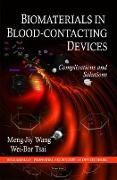Biomaterials in Blood-Contacting Devices
BücherAngebote / Angebote:
All blood-contacting medical devices in use today are subjected to some degree poorer blood compatibility than the native artery. Homeostatic mechanism, arresting bleeding from injured blood vessels, induces platelet adhesion and activation onto artificial biomaterials, which leads to undesirable outcomes such as blood clotting at the site of the implant, continual shedding of thrombi, and depletion of platelets from the blood stream. Such complications have hampered the clinical success of blood contacting devices, limiting the patent of small-diameter vascular grafts and making necessary the use of anticoagulants in patients undergoing extracorporeal bypass or synthetic heart valve implantation. Therefore, development of non-thrombogenic biomaterials is in great need for blood contacting devices. The current approaches mainly focus on surface modifications with biological anticoagulants such as heparin, or anti-fouling molecules like poly(ethylene oxide). In this review, the authors first introduce the blood components involved in hemostasis and thrombosis, followed by the common biomaterials applied in blood-contacting devices. Next, the complications induced by the interactions between blood and biomaterials are briefly addressed. Finally, the commonly used techniques for improving biomaterials' hemocompatibility are expatiated.
Folgt in ca. 15 Arbeitstagen
